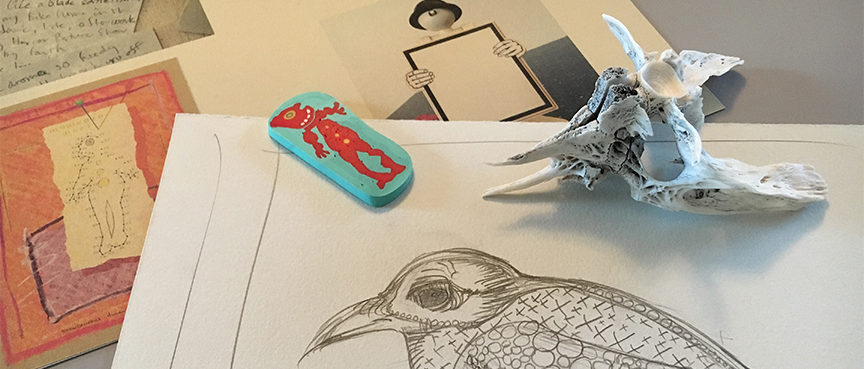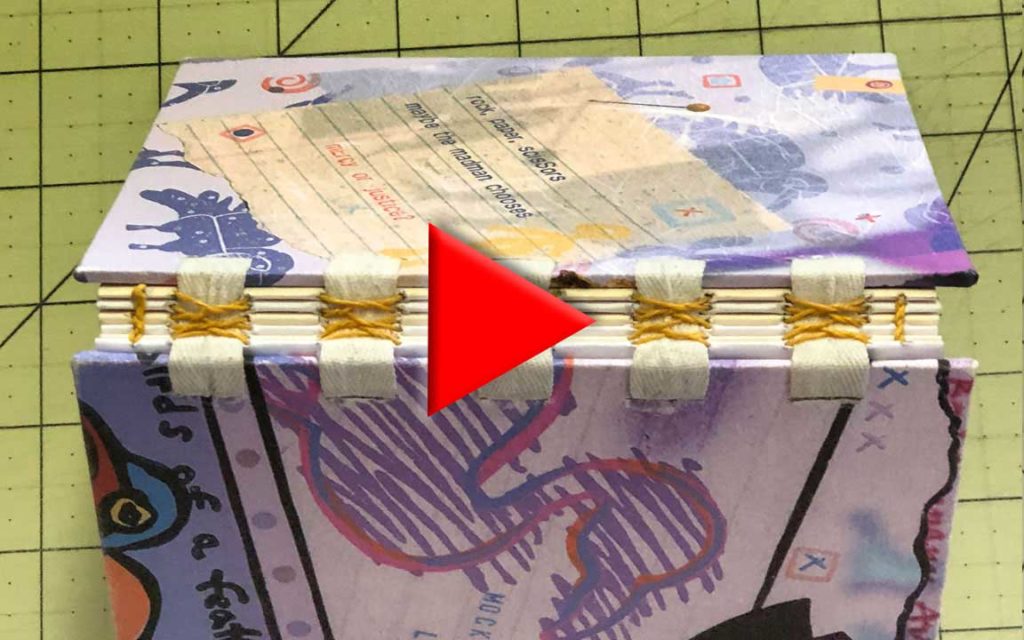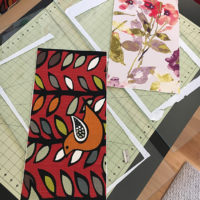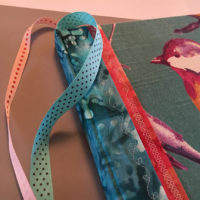French Link with Tape Cover – Part 1
The special cover and added tapes make this version of the French Link stitch a bit trickier, but the end result is unique and fun, so I think it’s worth the extra work.
Start by cutting your bookboards. Cut your bookboards so that you have about a quarter inch extra on each of three sides. The side that lines up with the spine will not need any extra space. So, for example, if your textblock is going to be 4 inches by 5 inches then your bookboards should be 4 ¼ inches by 5 ½ inches.
I like to create a template for marking the bookboard. Figure out how many tapes you want then divide the board up accordingly. You’ll want to mark the width of each tape plus an extra tick at each end. This will be the kettle stitch that anchors the book block at both ends.
Here’s a preview of why you’re creating these marks. You’ll be cutting ditches, or graves, in the boards to sink the tape into, then you’ll cover this back up with the tabs that you remove. Davey board is good for this because it is made up of layers that you can separate.
Mark the measurements on both boards. You can use the marks you’ve made on one board and copy them onto the second board. The edge of the graves on the spine side should be a quarter of an inch from the edge. Make the graves about a half inch wide. Copy these measurements onto the other board as well.
Before you start cutting anything mark each tape area with a unique identifier. I just mark them A B C, etc. In addition to marking the large piece that you’ll remove also make the same notation next to it so you’ll know where the tabs go back after they’ve been removed.
Cut along the outlines that you have marked for the graves. You’re not trying to go all the way through, just about halfway. Davey board is pretty tough so you’ll probably have to cut along those outlines several times to get them deep enough. Use a pointed tool to pull up the tabs. Sometimes these will separate easily and sometimes the result may be a little ragged.
This is a good time to segue to mentioning a great set of tools that’s worth the investment. If you think you’ll be making more books in the future you should buy one of these little dissection kits that vet students use. Every one of these tools is high grade, and the scalpels alone are worth the very cheap price. But you will find yourself reaching for all of these tools at one time or another. I paid a surprisingly cheap 17 dollars for this.
If you’re wondering why I didn’t use these tools in this video it’s because I unfortunately discovered this kit after the book was made. You’ll never see another video of mine that doesn’t use these tools.
Once you have all the tabs removed you’ll need to trim a little of the board off the back of the tabs , because the tape is obviously going to take up some space in the grave. When you glue the tab back in place you don’t want it to create a lump. Trim the tabs with a razor blade, X-acto knife or scalpel, being careful not to cut your fingers. I also like to mash down the grave a little bit to get rid of any imperfections left by the process.
Once you have the graves cut and the tabs trimmed, you’ll want to cut slits along the spine edge of each grave for the tapes to be pulled through. You can use a razor blade to do this but, again, a safer choice is probably an X-acto knife or a scalpel. Whatever tool you use, wiggle it back and forth a little to widen the slot once you have it cut. This will make inserting the tape a little easier. Be sure to make these cuts on the spine edge of each board.
So now you have the bookboards prepped – the graves are cut, the tabs have been trimmed and the slots in the graves are ready for the tape. Next, cut the pieces of tape. Be generous with the length and be sure to cut more than you’ll need.
The last step in your prep before assembling all of these parts is to cut the paper or bookcloth that you’re going to use. Give yourself an inch around each side of the paper for the flaps that you’ll fold in. The endpapers should be ½ inch smaller in each direction, giving you ¼ inch on each side of the board. So, if your bookboard is 4 x 5 inches, the bookcloth or paper should be 6 x 7 inches and the endpapers should be 3 ½ inches by 4 ½ inches.
So now you should have everything cut and ready. Start the construction process by gluing the paper to the bookboards. PVA glue is the choice of most bookmakers.
Make sure you have a generous, even layer of glue on the bookboard. Position it on the paper, making double-sure that you have everything headed the right direction, if your paper has a definite up-and-down orientation, and make sure that the spine is on the correct side. I’m eyeballing the positioning here, but if you need it to be exact, just draw guidelines on the back of the paper. Press this down with your hand, use a brayer or use a bone folder to make sure you get good contact.
Glue the second side exactly the same way, once again making sure that the spine is on the correct side of the paper. Place both sides under a heavy weight briefly just to ensure that the paper is thoroughly pressed down. It doesn’t have to be dry for the next step.
The next step is to miter the corners so that when you fold the flaps in you don’t end up with too much bulk in the corners. I use the 45 degree marking on my cutting mat to get an accurate angle, but you can eyeball this if you don’t have a cutting mat. Just try to be as accurate as you can. Don’t cut right up to the corner of the bookboard – cut about a quarter of an inch away. You’ll fold this excess in to hide the corner of the bookboard once you start gluing.
Do this for all of the corners on both bookboards.
Next you need to cut the slits along the spine all the way through the cover. This is where the tapes will be pulled in from the other side, which is the next step.
Start from the front side of the cover and force the tape through the slit you have cut in the board using whatever appropriate tool you have. This could be the back of a scalpel blade, the back of a single-edged razor blade, anything thin and stiff. You just need to get enough through the cut so that you can grab it and pull it through the rest of the way. I find that having tweezers for this step helps things go faster.
Once you have the tape pulled through, straighten it out so that it lies perfectly flat against the board, and adjust the length so that it just fills the grave.
Dab PVA glue into the grave and push the tape down firmly. Find the tab that matches that hole, apply glue to the back of it and push it down firmly. You can also press the tab down with any appropriate tool. This will help remove any bumps in the cover once the flap is glued down.
So now you should have all of the tapes glued in with the tabs glued on top. The last steps for this cover are to glue down the flaps and the endpaper. Use PVA glue for this and a scrap piece of paper to glue on. Be sure to get glue up into the corners. Press this down firmly with your hand, a brayer or a bone folder. If you are using a bone folder to rub the flap down, place a barrier paper in the way first. Using the bone folder directly on paper or bookcloth can damage it.
First glue down the two opposing sides, not worrying yet about the corners. When you apply glue to the third side be sure to get glue up into the little corner flap. Don’t get too excessive here, though, or the glue will gush out when you go to fold in the corner. Once you’ve applied the glue use your finger or a bone folder to push in the excess that left for the corner, being sure to cover the corner of the bookboard.
Do this on both sides of the flap and then fold the flap over as usual and firmly press it down, paying special attention to the corners. Keep a wet towel handy to wipe any excess glue off of your fingers or the bone folder. Finish the last flap in the same way.
The last step for this cover is to attach the endpaper. Again, you’ll use PVA glue for this step, applying the glue on a scrap piece of paper. Center this endpaper on your bookboard and press down firmly or rub it down with a bone folder. You’re done with this cover – just place it under a heavy weight and allow it to dry thoroughly before you begin sewing.
Watch Part 2 to see how to finish off this binding technique.



